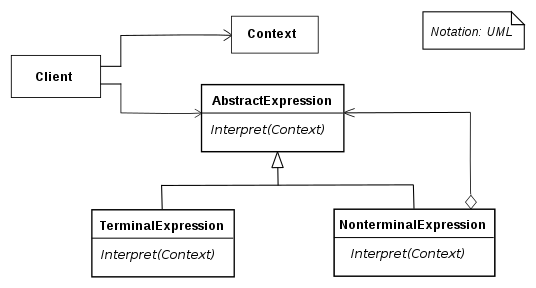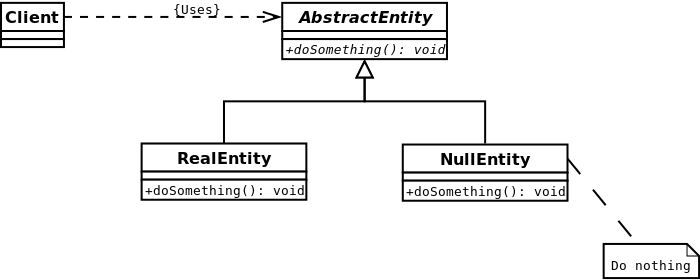Design patterns are guidelines for solving repetitive problems.

Quote from Wikipedia:
Software design pattern is a general, reusable solution to a commonly occurring problem within a given context in software design.
Introduction
In this post, we get active. We look at patterns that help us to get things done, whether interpreting a mini-language or encapsulating an algorithm.
Types of Design Patterns
- Performing and Representing Tasks
- Generating Objects
- Patterns for Flexible Object Programming
- Enterprise Patterns
- Database Patterns
The Interpreter pattern
The interpreter pattern is a design pattern that specifies how to evaluate sentences in a language. The basic idea is to have a class for each symbol (terminal or nonterminal) in a specialized computer language. The syntax tree of a sentence in the language is an instance of the composite pattern and is used to evaluate (interpret) the sentence for a client.

Purpose
Building a mini-language interpreter that can be used to create scriptable applications.
Example
Unit converter.
Implementation
<?php
interface Converter
{
public function show();
}
// === A Simple Converter ===
// That convert Gallon to Litre
class GallonToLitre implements Converter
{
private $gallon;
public function __construct($gallon)
{
$this->gallon = $gallon;
}
public function show()
{
return round($this->gallon * 3.79);
}
}
// === A Simple Converter ===
// That convert Mile to Kilometer
class MileToKilometer implements Converter
{
private $mile;
public function __construct($mile)
{
$this->mile = $mile;
}
public function show()
{
return round($this->mile * 1.6);
}
}
// === An Intepreter ===
// That interpret to Kilometer per Litre by using existing converters.
// Consider this as structuring a sentence using grammers (converters).
class MpgToKml implements Converter
{
private $g2l;
private $m2k;
public function __construct(Converter $g2l, Converter $m2k)
{
$this->g2l = $g2l;
$this->m2k = $m2k;
}
public function show()
{
echo $this->g2l->show() . "l/" . $this->m2k->show() . "k\n";
}
}
$mpg2kml = new MpgToKml(new GallonToLitre(1), new MileToKilometer(20));
$mpg2kml->show();
// Output: 4l/32kThe Strategy pattern
The strategy pattern (also known as the policy pattern) is a software design pattern that enables selecting an algorithm at runtime. Instead of implementing a single algorithm directly, code receives run-time instructions as to which in a family of algorithms to use.

Purpose
Identifying algorithms in a system and encapsulating them into their own types.
Example
Car selection algorithm based on the day of the week.
Implementation
<?php
interface Car
{
public function pick();
}
class Fit implements Car
{
public function pick()
{
echo "Picking Fit for today.\n";
}
}
class Vitz implements Car
{
public function pick()
{
echo "Picking Vitz for today.\n";
}
}
// === CarPickerStrategy ===
// That decide which car object to use based on the situation
// The benefit is that we can add more strategies later,
// clients doesn't have to know or change their implementation
class CarPickerStrategy
{
public $today;
public function __construct($today)
{
$this->today = $today;
}
public function pick()
{
if( $this->today == "Monday" ) {
$car = new Vitz();
} else {
$car = new Fit();
}
$car->pick();
}
}
// ---
$carpicker = new CarPickerStrategy("Sunday");
$carpicker->pick();
// Output: Picking Fit for today.
$carpicker->today = "Monday";
$carpicker->pick();
// Output: Picking Vitz for today.The Observer pattern
The observer pattern is a software design pattern in which an object, called the subject, maintains a list of its dependents, called observers, and notifies them automatically of any state changes, usually by calling one of their methods.

Purpose
Creating hooks for alerting disparate objects about system events.
Example
You have a list. When there is a change, you need invoke update() on each element in a list.
Implementation
<?php
// === Subject ===
// Have a observer list. When there is a change,
// iterate through observer list and invoke update()
// on each observer.
class Car
{
protected $phones = []; // observer list
protected $status;
public function attach(Phone $phone)
{
$this->phones[] = $phone;
}
public function getStatus()
{
return $this->status;
}
public function setStatus($status)
{
$this->status = $status;
$this->notify();
}
public function notify() {
foreach($this->phones as $phone) {
$phone->update();
}
}
}
// === Observer ===
// Which add itself to observer-list of subject,
// by invoking attach() method of the subject.
class Phone
{
private $car;
public $name;
public function __construct(Car $car, $name)
{
$this->name = $name;
$this->car = $car;
$this->car->attach($this);
}
public function update()
{
echo $this->name . " - Car is " . $this->car->getStatus() . "\n";
}
}
// ---
$car = new Car();
$iphone = new Phone( $car, "iPhone" );
$nexus = new Phone( $car, "Nexus" );
$car->setStatus("driving");
// Output:
// iPhone - Car is driving
// Nexus - Car is drivingThe Visitor pattern
The visitor design pattern is a way of separating an algorithm from an object structure on which it operates. A practical result of this separation is the ability to add new operations to existent object structures without modifying the structures.

Example
Applying an operation to all the nodes in a tree of objects.
Implementation
<?php
class Car
{
public $color = "Silver";
// accepting Enhancer as visitor
public function visitor(Enhancer $enhancer)
{
$this->color = $enhancer->enhance( $this );
}
}
// === A visitor ===
// That can visit into Car object change it
// The benefit is, Car object is now seperated from
// detail algorithm of how it can be enhanced
class Enhancer
{
// visiting into Car
public function enhance(Car $car)
{
return "Matelic $car->color";
}
}
// ---
$car = new Car();
echo $car->color . "\n";
// Output: Silver
$car->visitor(new Enhancer());
echo $car->color . "\n";
// Output: Matelic SilverThe Command pattern
The command pattern is a software design pattern in which an object is used to encapsulate all information needed to perform an action or trigger an event at a later time. This information includes the method name, the object that owns the method and values for the method parameters.

Purpose
Creating a simple interface to complex or variable systems.
Example
On and off the lamp.
Implementation
<?php
class Lamp
{
public function open()
{
echo "Lamp is opened.\n";
}
public function close()
{
echo "Lamp is closed.\n";
}
}
interface Button
{
public function execute();
}
// === A command that can be executed on Lamp ===
class SwitchUp implements Button
{
public $lamp;
public function __construct(Lamp $lamp)
{
$this->lamp = $lamp;
}
public function execute()
{
$this->lamp->open();
}
}
// === A command that can be executed on Lamp ===
class SwitchDown implements Button
{
public $lamp;
public function __construct(Lamp $lamp)
{
$this->lamp = $lamp;
}
public function execute()
{
$this->lamp->close();
}
}
// === A Collection ===
// That accept and execute commands
class Commands
{
public $commands = [];
public function add(Button $button)
{
$commands[] = $button;
$button->execute();
}
}
// ---
$lamp = new Lamp();
$up = new SwitchUp($lamp);
$down = new SwitchDown($lamp);
$commands = new Commands();
$commands->add($up);
// Output: Lamp is opened.
$commands->add($down);
// Output: Lamp is closed.The Null Object pattern
In object-oriented computer programming, a null object is an object with no referenced value or with defined neutral ("null") behavior. The null object design pattern describes the uses of such objects and their behavior (or lack thereof).

Example
Using non-operational objects in place of null values.
Implementation
<?php
interface Car
{
public function drive();
}
class Fit implements Car
{
public function drive()
{
echo "Driving Fit...\n";
}
}
class Vitz implements Car
{
public function drive()
{
echo "Driving Vitz...\n";
}
}
// === Null implementation ===
// A blank implementation similar to real one
class NullCar implements Car
{
public function drive()
{
//
}
}
$name = null;
switch($name) {
case "Fit":
$car = new Fit(); break;
case "Vitz":
$car = new Vitz(); break;
default:
$car = new NullCar();
}
// ---
$car->drive();
// Output: [nothing]
// We avoided `Call to a memeber function on null` error here.
// Without NullCar object the code will look like following
// to avoid such error.
//
// if( isset($car) and $car instanceof Car ) {
// $car->drive();
// }Summary
In this post, we looked at patterns that help us to get things done.
Marat Badykov
Full-stack web developer. I enjoy writing Php, Java, and Js.
